The vehicle centre of gravity and the usual driving characteristics as well as the steering and braking characteristics alter.
If you exceed the maximum roof load, the driving characteristics, as well as steering and braking, will be greatly impaired.
You will find information on the maximum roof load in the "Technical data" section in the printed Owner's Manual.
The panorama sliding sunroof may be damaged by the roof luggage rack if you attempt to open it when using a roof luggage rack not tested and approved for Mercedes-Benz.
The panorama sliding sunroof may be raised to allow ventilation of the vehicle interior.
When you adjust a seat, you may trap yourself or a vehicle occupant.
The seat and seat backrest can fold forwards.
The vehicle occupant may be pressed against the seat belt. The seat belt cannot protect as intended and could cause additional injury.
A child restraint system is no longer properly supported or positioned and can no longer fulfil its function as intended.
The seat backrest cannot restrain objects or goods in the load compartment.
Before persons travel in the vehicle while sitting on a seat with the easy entry and exit feature
After you have adjusted the seat
After the easy entry and exit feature has been used
After the load compartment enlargement has been folded forwards
Always ensure that all vehicle occupants have their seat belts fastened correctly and are sitting properly. Particular attention must be paid to children.
If you no longer require the folded-down rear seat backrest as a load area, fold the backrest back into place.
Make sure that the red marking of the lock verification indicator is no longer visible. Otherwise, the seat backrest will not be locked.
Depending on the vehicle equipment, a message will be displayed on the instrument cluster instead of the red lock verification indicator.
Depending on the vehicle equipment, you can fold the outer seat backrests forwards mechanically.
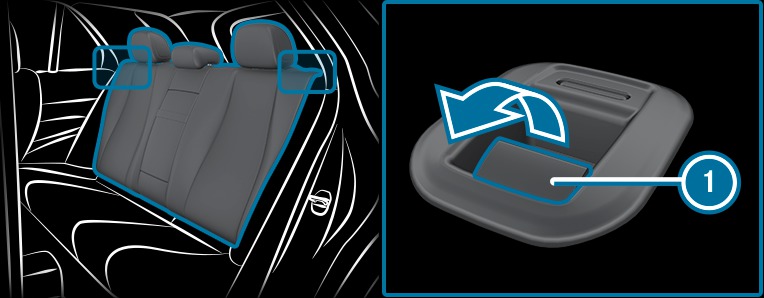
 .
. 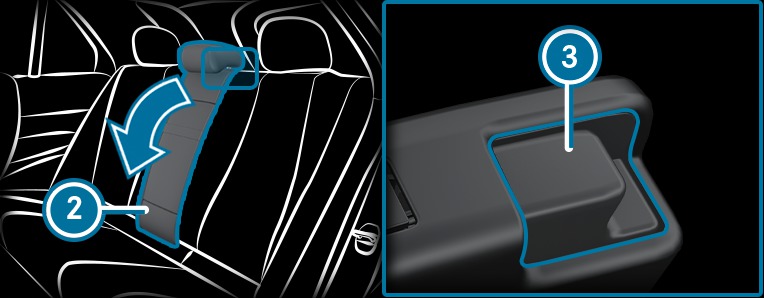
 .
.  forwards.
forwards. If you wish to fold only one of the outer seat backrests forwards, it is recommended that you fold the right seat backrest forwards.
If you wish to fold one of the outer seat backrests forwards together with the centre seat backrest, it is recommended that you fold the left and centre seat backrests forwards.
If a seat in the second row of seats is not engaged and locked, this will be shown on the multifunction display on the instrument cluster.
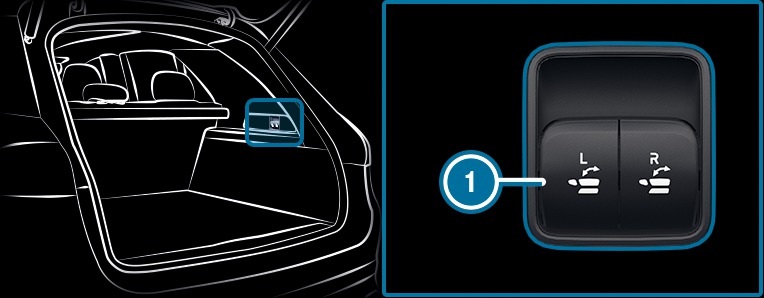
 .
. The head restraint in the rear will move into a suitable position. The rear seat will fold forwards. The centre seat backrest will fold forwards together with the left seat backrest.
If you wish to fold only one of the outer seat backrests forwards, it is recommended that you fold the right seat backrest forwards.
If you wish to fold one of the outer seat backrests forwards together with the centre seat backrest, it is recommended that you fold the left and centre seat backrests forwards.
When you adjust a seat, you may trap yourself or a vehicle occupant.
The rear bench seat, rear seat and seat backrest may fold forwards, even while the vehicle is in motion.
As a result, the vehicle occupant will be pressed into the seat belt with increased force. The seat belt will not be able to protect as intended and could cause additional injury.
Objects or loads in the boot or load compartment cannot be restrained by the seat backrest.
The seat belt could become trapped and thus be damaged when the seat backrest is folded back.

 back until it engages.
back until it engages. 
 .
. The rear seat will fold back. The centre seat backrest will fold back together with the left-hand seat backrest.
If a seat backrest is not engaged and locked, this will be shown on the multifunction display on the instrument cluster.
If you drive with the load compartment floor open, objects could be flung around and hit vehicle occupants as a result. There is a risk of injury, particularly in the event of sudden braking or a sudden change in direction.
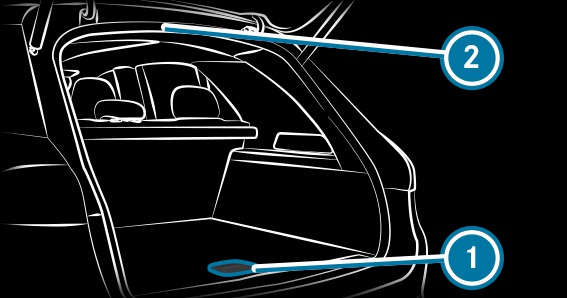
 upwards.
upwards.  .
.  .
.  and fasten it to the holder on the underside of the load compartment floor.
and fasten it to the holder on the underside of the load compartment floor.  down until it engages.
down until it engages. If the ball neck is not engaged, the trailer may come loose.
The all-electric trailer hitch could be mechanically damaged by applying additional pressure when the ball neck is being extended or retracted.
The vehicle is secured against rolling away.
The swivel range is clear.
The trailer cables or adapter plugs have been removed.
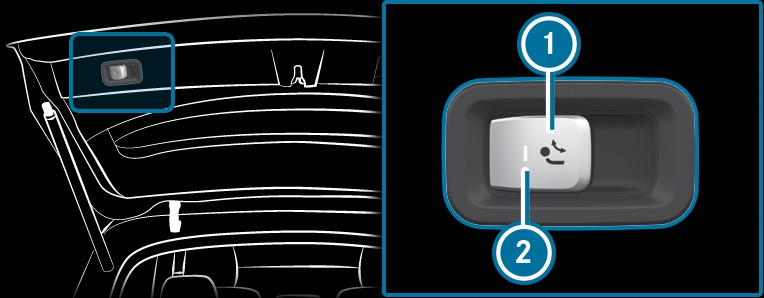
 .
. Indicator lamp  will flash and the message Trailer coupling extending… will appear on the multifunction display.
will flash and the message Trailer coupling extending… will appear on the multifunction display.
The ball neck will extend fully electrically.
When indicator lamp  is continuously lit, the ball neck is securely locked in place.
is continuously lit, the ball neck is securely locked in place.
If the ball neck is not securely locked in place, indicator lamp  will flash and the message Check trailer hitch lock will appear on the multifunction display.
will flash and the message Check trailer hitch lock will appear on the multifunction display.
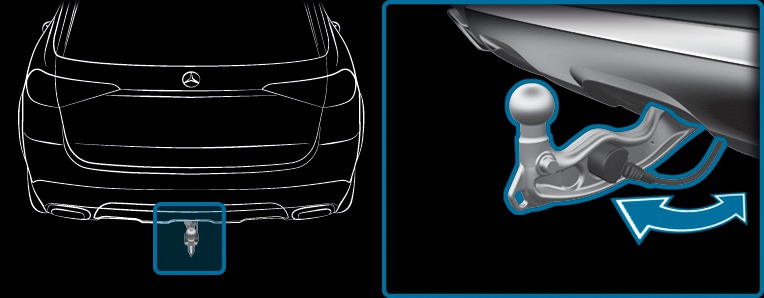
 .
. Indicator lamp  will flash and the message Trailer coupling extending… will appear on the multifunction display.
will flash and the message Trailer coupling extending… will appear on the multifunction display.
The ball neck will retract fully electrically.
When indicator lamp  goes out, the ball neck is securely locked in place.
goes out, the ball neck is securely locked in place.
If the ball neck is not securely locked in place, indicator lamp  will flash and the message Check trailer hitch lock will appear on the multifunction display.
will flash and the message Check trailer hitch lock will appear on the multifunction display.
Observe the notes on loading the vehicle More.
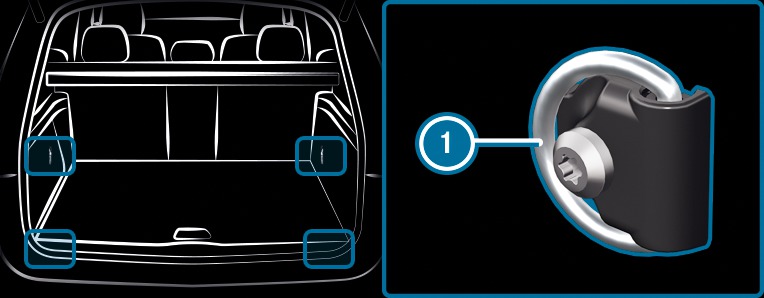

If objects in the vehicle interior are stowed incorrectly, they can slide or be thrown around and hit vehicle occupants. In addition, cup holders, open stowage spaces and mobile phone receptacles cannot always retain all objects within.
There is a risk of injury, particularly in the event of sudden braking or a sudden change in direction.
Observe the notes on loading the vehicle.
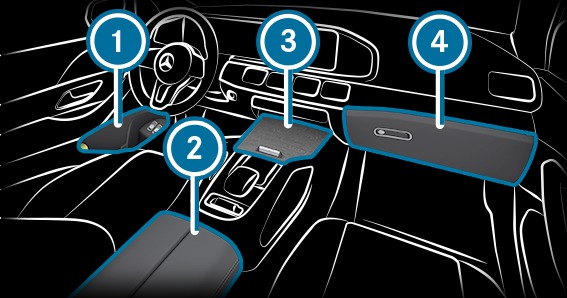




If objects in the vehicle interior are stowed incorrectly, they can slide or be thrown around and hit vehicle occupants. In addition, cup holders, open stowage spaces and mobile phone receptacles cannot always retain all objects within.
There is a risk of injury, particularly in the event of sudden braking or a sudden change in direction.
Observe the notes on loading the vehicle.
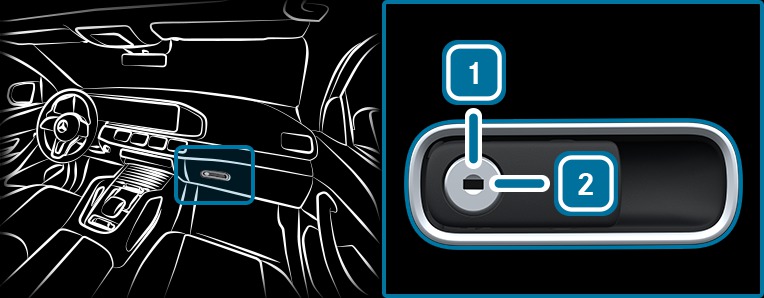
 (to lock) or anti-clockwise
(to lock) or anti-clockwise  (to unlock).
(to unlock). If objects in the vehicle interior are stowed incorrectly, they can slide or be thrown around and hit vehicle occupants. In addition, cup holders, open stowage spaces and mobile phone brackets cannot always retain all objects they contain.
There is a risk of injury, particularly in the event of sudden braking or a sudden change in direction.
The cup holder cannot hold a container secure while the vehicle is in motion.
If you use a cup holder while the vehicle is in motion, the container may be flung around and liquids could be spilled. The vehicle occupants may come into contact with the liquid and if it is hot, they could be scalded. You could be distracted from traffic conditions and you may lose control of the vehicle.
Observe the notes on loading the vehicle.
When folded out, the rear armrest can be damaged by body weight.
In vehicles with a folding rear seat armrest, this can be folded down to allow the stowage compartments to be used. The available rear armrests and stowage compartments vary depending on the vehicle equipment.
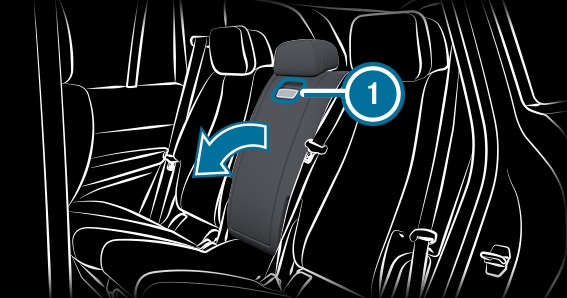
 and fold down the rear armrest.
and fold down the rear armrest. 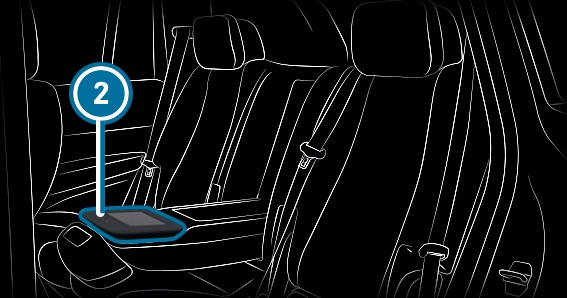
 More.
More. 
